Gravitating towards innovation is a natural fit for Passive House professionals, so organizing a tour to visit inventive manufacturers was an easy tag-on to a trip to attend this year's International Passive House Conference in Innsbruck, Austria. My goal was to investigate a couple of products I’m looking to use in upcoming projects at my own design firm in California. I was readily joined by four other Passive House professionals, all with a shared interest in learning about the latest innovations in high performance, low embodied emissions products.
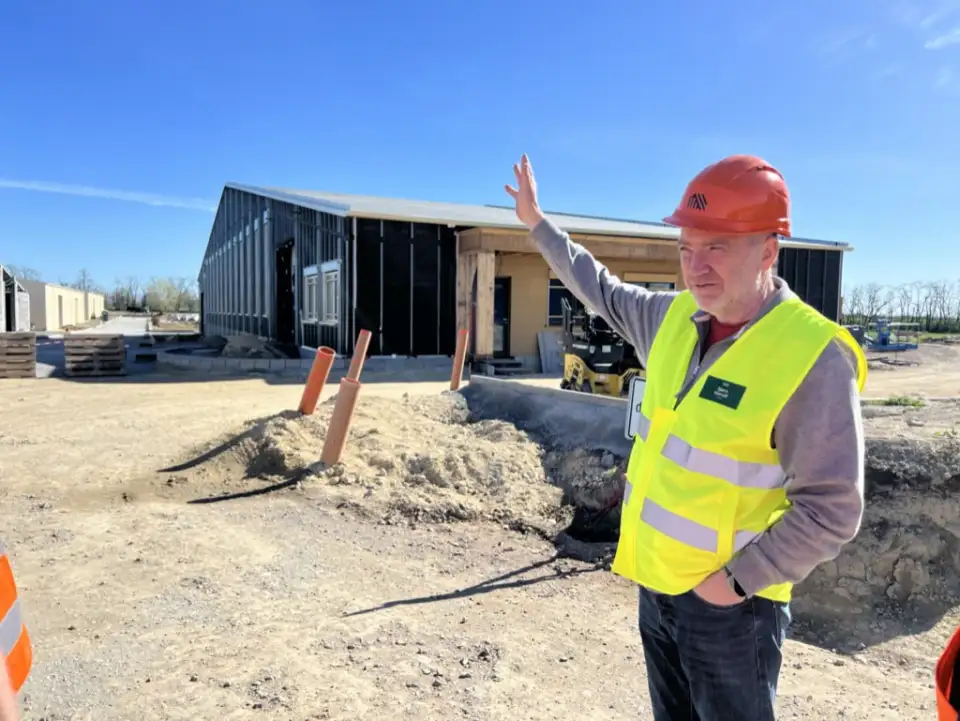
2024 Innovation Tour
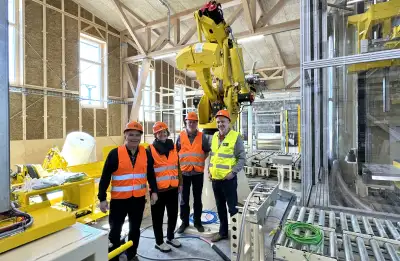
Our first stop was the new Ecococon factory located just outside Slovakia’s capital, Bratislava, which is a short and pleasant train journey from Vienna. This factory is the second production facility for this established straw panel company, with the first located in Lithuania. The goal for the newer site is to establish a fully mechanized, replicable factory prototype that can simultaneously accelerate production and reduce labor costs. While still under construction, we were able to see the almost completely robotic assembly line, including a proprietary machine Ecococon’s team has designed to optimize the strand orientation and compression of the straw inside their panels. (We were asked not to photograph this machine for obvious reasons.)
While the robotic machinery was not yet operational, we were able to admire the thoughtful construction of the factory itself, fully designed as a Passive House building. In keeping with the low-upfront-carbon emissions philosophy of this company, all-wood, tree-like structural posts were used to support the gabled factory roof. The windows are PHI-certified wood-framed windows by Smartwin, made locally in Slovakia by one of Smartwin’s cooperative partners. The shape, size, and height of the building was clearly optimized to the footprint of the equipment it needed to house. A small office area with a modest showroom, bathroom, and employee break room adjoins the open-plan factory floor and provides room for the business operations, along with the small staff that will be required to provide quality control and maintenance, once the factory is operational.
Our gracious host, CEO Bjorn Kierulf, was impressively generous with his time. He told us how the development process has provided his team with a great deal of insight into how to optimize the production process of these carbon-positive panels. The factory demonstrates an intriguing marriage of high-tech robotics and low-tech bio-materials.
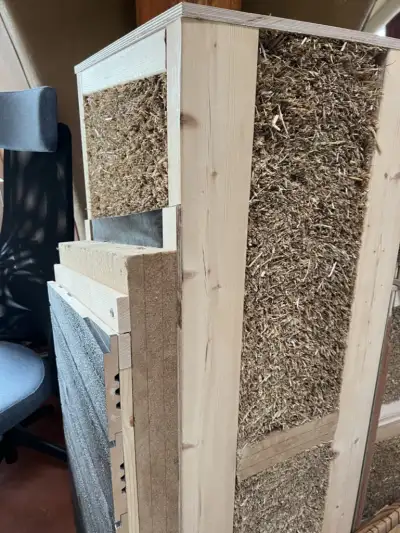
Bjorn was kind enough to extend our tour to visit a number of projects built using the Ecococon panels. We visited two completed homes, an artist studio complex, plus a ten-home residential subdivision, still under construction. Their designs varied from rustic to contemporary, with exterior finishes ranging from natural clay to brick veneer, providing a spectrum of options to either celebrate and expose the straw panels, or disguise them completely.
At dinner that evening we were introduced to the visionary investor helping Ecococon to scale its production capacity and incorporate robotics into its manufacturing process. It was not surprising that she is a techie herself, with a background in security software. She shared her excitement for supporting local innovation, particularly as it aligned with her family’s ambitions to foster scalable, local manufacturing with great ecological outcomes. This goal resonated with all of us, especially those of us from places like California, where our high labor costs have previously prevented Ecococon from setting up shop to produce these innovative panels.
After two delightful days in Slovakia, we headed west to the Beck Fasteners factory, located in a remote village an hour north of Salzburg. We were welcomed by the full R&D team, including CEO Christian Beck, and treated to a comprehensive tour of the factory to witness a wide variety of staples and nails being manufactured, before sitting down to learn more about the product we came to see: Lignoloc wooden nails. Unfortunately, the wooden nails were not in production that particular day as our visit did not align with their typical production schedule.
Two things stood out on this stop. The first was the long history of innovation at Beck, which apparently was where building staples were invented to solve a printing press business problem. The second was the agile business acumen of this family. Beck currently produces an impressively extensive range of fastening products—not only under their own label, but also for a number of other companies, including Fasco and Bosch. This production agility, along with their ability to continue innovating and adapting, made the visit truly impressive. This inventiveness is clearly part of the Beck DNA and readily apparent in the bold departure from metal to wood fasteners.
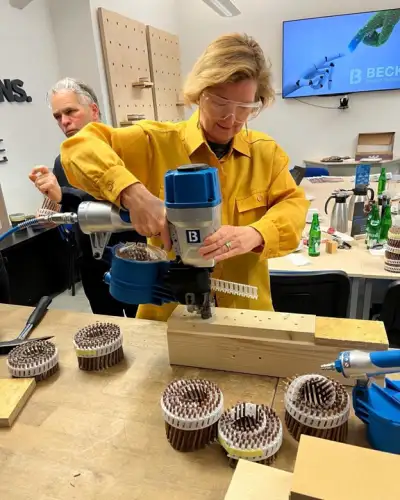
The Lignoloc origination story was equally compelling. As CEO Christian Beck tells it, he was not particularly inspired to take over the family business until he tugged on the innovation thread that clearly runs through the history of this company. The opportunity to develop new products and lead the family business finally captured his interest. He assembled a team and brought in R&D collaborators to drive the development of the collated wooden nail product, including a custom-designed pneumatic gun. I’d seen the original headless prototypes in 2017, and now this product line has been expanded to include an option with heads, with both in an array of widths and lengths. Our group was shown these newer wooden nails with heads, plus a product being used at a nearby massive timber manufacturer, where glue-free, cross-laminated timber panels are being produced using the Lignoloc nails (appropriately known as LNLT for Lignoloc Nail Laminated Timber). Before our departure, we were given time to drink Lignoloc-inspired beer and ‘shoot wood’ using the Lignoloc nail guns. As you can imagine, extraction was difficult…
Our last stop on this tour was the PHI conference in Innsbruck. The trade show at this event has historically been packed with additional innovation, and despite being smaller than usual this year, it did not disappoint. Standouts included an updated ‘magic box’ from Pichler—a fully integrated ventilation+cooling+heating+domestic hot water box that has long intrigued me. (We had already seen these Pichler products installed in all the projects Bjorn Kierulf showed us in Slovakia.)
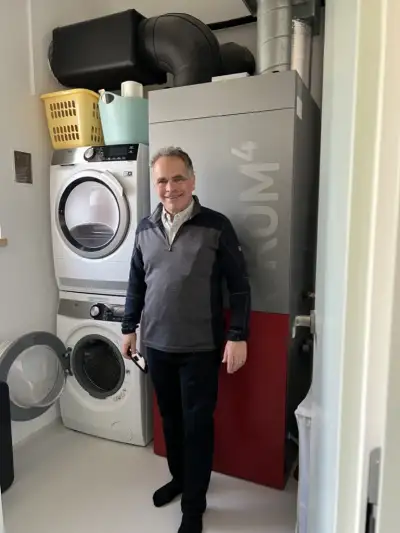
These fully integrated HVAC boxes remain frustratingly absent from our U.S. product market. This year Pichler showed off their new-ish enhancement: integrated PV + battery storage, all neatly packaged in a compact add-on to their original well packaged unit. This is the kit I have been drooling over on past visits to Europe over the last fifteen years, and I am still wondering why this product type has remained so elusive to our U.S. product supply chain. What building professional wouldn’t want all their HVAC needs delivered in a preassembled, fully integrated and compact box? This is prefabricated HVAC, or i-HVAC— with the i standing for integrated—and I’d LOVE to see an entrepreneurial American either develop a similar product, or establish a distribution partnership with Pichler (which Pichler’s CEO is very open to.) Alternatively, why not take a cue from Beck Fasteners and perhaps manufacture these elegant units under a local brand name?
The expo featured a number of other intriguing products, including a new option for air leakage testing, plus a window-frame integrated ventilation unit designed especially for retrofits. However, samples from this Passivhaus candy shop left a frustratingly bittersweet aftertaste. The tradeshow was loaded with building product candy I cannot access—despite living and working in the perceived center of the tech universe. I continue to be puzzled by how slow the U.S. construction market has been to adopt and develop products required for high performance buildings, particularly HVAC products. This continues to hamper our ability to optimize cost and performance—especially for retrofits, where we are least able to rely on the envelope to do the heavy load-reduction lifting.
While I returned from this tour frustrated and inspired in equal measure, I remain hopeful that our North American Passive House community will continue to build demand for higher performance, carbon-positive, fully integrated products. My favorite souvenir from this journey is the memory of the delight on the faces of my touring companions, who were equally excited by the possibilities presented to us at each stop. In order to unblock our high-performance product spigot I firmly believe we need to help seed programs and policies that scale demand. For this reason, I encourage everyone to read and share PHN’s ‘Stepping Up To Passive’ brief so you may actively guide local advocates, policymakers, and politicians in how to successfully scale Passive House building growth. We must build robust demand to support the development of our own similarly inspiring products. Until then, I remain ever-hopeful that i-HVAC will one day become available for my clients on the left coast.